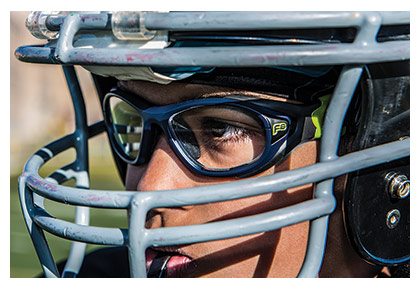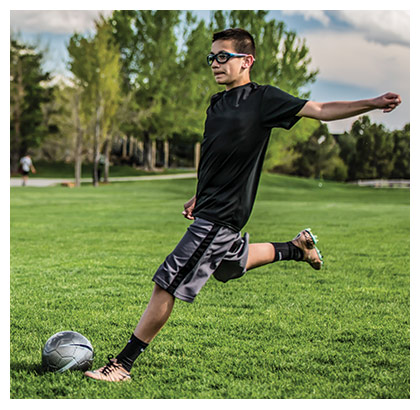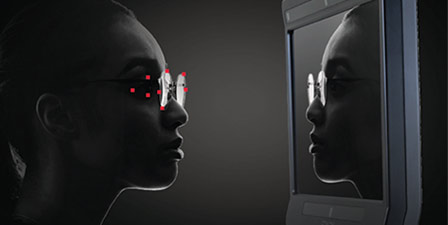
By Deborah Kotob
A win for the patient is a win for the practice! The sports protective eyewear conversation is fundamental to quality patient care, but it’s also a practice builder that increases patient loyalty and provides a new revenue stream.
Dr. Alan Reichow, sports vision expert and doctor to Olympians, professional athletes and founder of the Performance Vision Center Program states the following: “As eyecare practitioners, we have the legal duty and responsibility to identify those patients at risk of eye injury and to educate them on the risks. Sport protective eyewear should be part of an ‘equipment safety check list’ and is the second pair requirement for children.”
Prevent Blindness reports that there are over 35,000 sports-related eye injuries annually and rising in the U.S. Liberty estimates that over 90 percent of such injuries are preventable. Sports-related eye injuries are costly, painful and can even result in blindness. Children bear the heaviest burden from sports-related eye injuries. Over 50 percent of children participate in sports, and they suffer the majority of related eye injuries. Sports-related injuries are the number one cause of blindness in children in the U.S., according to the National Eye Institute. Sports and play are too tough for everyday eyeglasses. Powerful voices champion this cause and actively campaign to reduce preventable sports-related eye injuries.
 The Performance Vision Center Program, born from a collaborative partnership between Prevent Blindness America, Liberty and Dr. Alan Reichow, is one of the leading voices campaigning to increase awareness of and reduce the incidence of sports-related eye injuries. This program recognizes eyecare professionals dedicated to protecting and enhancing vision through education, assessment and intervention. The three tenets of this program are: 1. Defending vision. 2. Sports and play are too rough for everyday eyeglasses, and 3. Sports protective eyewear like Rec Specs is the second pair that every child needs.
The Performance Vision Center Program, born from a collaborative partnership between Prevent Blindness America, Liberty and Dr. Alan Reichow, is one of the leading voices campaigning to increase awareness of and reduce the incidence of sports-related eye injuries. This program recognizes eyecare professionals dedicated to protecting and enhancing vision through education, assessment and intervention. The three tenets of this program are: 1. Defending vision. 2. Sports and play are too rough for everyday eyeglasses, and 3. Sports protective eyewear like Rec Specs is the second pair that every child needs.
The Performance Vision Center Program, led by Dr. Reichow, includes sports-related eye injury roundtable discussions among optometrists, opticians, athletes and trainers. Their conclusion: The entire practice must engage in this conversation with the patient. Adopting best practices to reduce sports-related eye injury provides a new revenue stream and practice growth potential. By actively expressing concern and interest in the visual welfare and performance eyewear needs of every patient, the practice distinguishes itself. This level of care demonstrates your commitment to your patient, and they will reward you with their loyalty.
Dr. Reichow shares his perspective on easy steps to integrate sports protective eyewear into the practice. “Make it a practice mission to reduce sports-related eye injuries. Engage the patient in conversation regarding their sports and other activities—this will provide an opportunity to increase their awareness of the need for protective eyewear. And it’s something that everyone in the practice has a role in—from reception to the exam to the eyewear dispensary.
RECEPTION - EXAM - OPTICAL DISPENSARY
The conversation begins at scheduling; the receptionist advises the patient to bring ALL eyewear (prescription and nonprescription) to the appointment. During check-in, patient history and a lifestyle survey questionnaire are collected, and all activities and sports are noted.
The waiting room is an opportunity to inform and educate the patient. Videos such as “Versus” from Liberty shows the added impact protection provided by Rec Specs over regular eyeglasses when struck by a ball. Seeing is believing. This video is a powerful tool to help you raise awareness of parents who are the guardians of their child’s health and eye health.
The conversation continues in the exam room where the doctor, their trusted eyecare provider, discusses vision needs including the options for SAFE vision protection for the workplace, school, around the home, sports and recreational activities.
In the optical dispensary, the conversation comes full circle. The optician assesses vision solutions based on exam results and doctor recommendations, and current eyewear issues. Opportunities related to eye protection are identified.
All existing eyewear and helmets/head gear are examined to assure safety compliance. If not, explain why. Is the eyewear certified as use indicates? And then demonstrate appropriate sport protective eyewear such as Rec Specs from Liberty, for both plano and prescription eyewear.
Very important: Sports and play are too tough for everyday eyewear. Many athletes wear their everyday eyewear in sports and recreational activities, which can put them at increased risk of serious eye and face injury, caused by breakage of the eyewear during sport.
It is our responsibility to do everything we can to protect the precious sight of our active youth and adult patients. This should be the primary focus of all practices.












